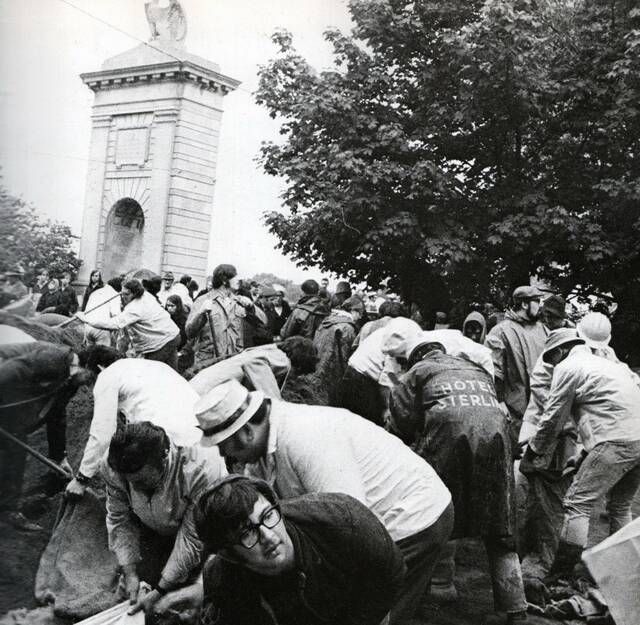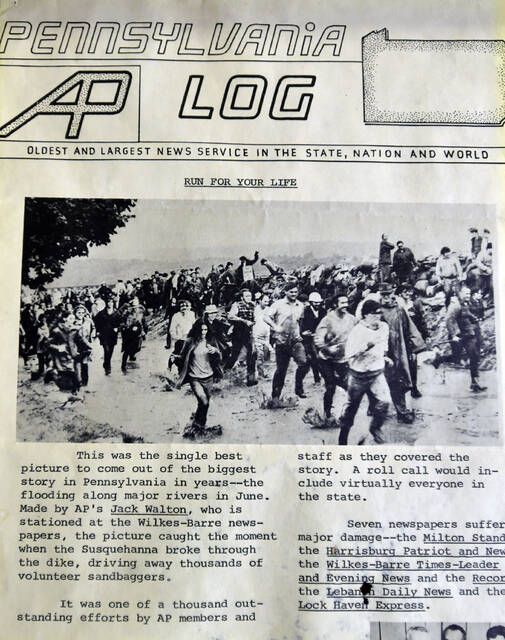‘The next thing I knew, I was filling sandbags’
Click here to subscribe today or Login.
WILKES-BARRE — John Churnetski was supposed to start his new job on a Monday, but he decided to go to his new office on the Friday before to check things out.
So Churnetski, wanting to make a good impression, wore a nice pair of pants, a crisp white shirt, a tie and he threw on his tan raincoat.
And off Churnetski went to his new job as Luzerne County Engineer. It was raining — a lot.
It was Friday, June 23, 1972, the day of the Agnes flood.
Churnetski’s first day on the job proved to be unforgettable: a baptism not by fire, but by water — dirty, unholy water.
“I was all set to check out my office, meet some people and the next thing I knew, I was filling sandbags,” Churnetski recalled. “In a matter of minutes, my clothes were totally saturated and I was filthy dirty. Welcome to the county engineer’s position.”
Churnetski smiled a little, but he also thought about that day and the days following and he remembered the extraordinary leadership of Gen. Frank Townend and the members of what was then the Civil Defense Team.
“The flood happened — nothing could have stopped it,” Churnetski said. “Working with Gen. Townend gave me the opportunity to learn and to appreciate what leadership was all about.”
Churnetski, 31 at the time, was just six years out of college.
“I knew nothing about flooding up until then,” he said. “Most of us knew little about flooding. That’s why Gen. Townend’s leadership was so important. He knew what had to be done.”
Townend, a former Army general, knew how to organize and he knew how to muster people together for the common good, Churnetski said. He knew what agencies to contact and he knew who to contact in those agencies. He knew government officials and he knew the elected officials.
“I also remember a common thread — the resiliency and determination of the people,” Churnetski said. “Everybody had just gotten punched in the mouth and they got back up and took care of things.”
Churnetski remembered U.S. Rep. Dan Flood, who stood before Congress and convinced his colleagues to approve 1 percent loans for all flood victims to re-finance their home loans and make it easier for them to clean up, repair and move back in to their homes.
“That was a godsend,” Churnetski said.
On that first day on the job, Churnetski was faced with the worst flooding of the Susquehanna River Basin on record.
In Pennsylvania, 48 lives were lost and an estimated $2.8 billion in damage was incurred — translating to about $14 billion in today’s dollars.
According to the National Oceanic and Atmospheric Administration, Tropical Storm Agnes stalled over New York and Pennsylvania from June 21 through June 24, 1972, dumping between 10 and 18 inches of rain over the area.
“My raincoat was no match for Agnes,” Churnetski quipped. “When I got to the courthouse, it was a madhouse, so I jumped in and helped.”
Churnetski said that at the time he was operating a small engineering firm and got a call from then-county Commissioner Ed Wideman, who asked him if he was interested in replacing Bernie Gallagher as county engineer. Gallagher had accepted a new position as city manager for the city of Wilkes-Barre.
“I remember telling Mr. Wideman that I would like to talk to Bernie about the position and what the demands were, like hours and such,” Churnetski said. “Back then, the county engineer was a part-time job, but I wanted to talk to Bernie first.”
Churnetski said Gallagher assured him that he would not have to spend a lot of time on the job and that he would act more as a consultant to the county commissioners regarding matters that required engineering input.
“So I agreed to take the job and went over there on that Friday (June 23, 1972), and I don’t think I went home for three or four weeks,” Churnetski said. “So much for limited involvement.”
Then-President Richard M. Nixon, who visited the Wyoming Valley and toured the devastation with then-Congressman Dan Flood and presidential aide Frank Carlucci, declared Pennsylvania a disaster area.
Even entertainer Bob Hope visited the area.
In Forty Fort, an entire section of the historic cemetery was washed away and about 2,000 caskets were uprooted from their graves, leaving body parts on back porches, roofs and basement floors.
Towns were left with massive cleanup projects. Some homes were lifted from their foundations and carried miles downstream. Estimates at the time said the river had swollen to one mile in width.
Former Luzerne County Engineer Jim Brozena, who succeeded Churnetski, said what is important now is to know where we are today – what has been done to prevent another disastrous flood like Agnes.
“The project was started in 1997 and completed in 2002 and the cost was $200 million,” Brozena said. “Will I say that we will never see another flood? No, I can’t say that, but the chances are way less.”
There have been a couple of close calls — 2011 being the closest we came to another Agnes-like flood. But the levee system held.
Brozena said that, regardless of the flood protection in-place, people will always get nervous when the river starts to rise.
Tropical Storm Agnes caused the Susquehanna River to rise over 40 feet. When the water came over and through the levees, much of Wyoming Valley was devastated. Rebuilding was a tremendous challenge, but the community has come back.
In an interview 15 years ago, Churnetski said he could remember a lot of discussion right after the flood centering on leveling Wilkes-Barre and starting over.
“These were people who were knowledgeable and who were committed to just wiping out the city,” Churnetski said. “They felt we should just get rid of all the buildings and start over. I always felt we could protect the valley. It didn’t make sense to me to demolish everything.”
Then Churnetski remembered the near-miss of Hurricane Eloise in 1975.
“The river was rising to 35 or 36 feet and we were thinking, here we go again,” Churnetski said. “I mean the river water was lapping at the top of the dike. Thankfully, the dikes held and the river receded.”
Churnetski said he was glad to see the completion of the Susquehanna Riverfront Project. He said it makes for a great attraction to the valley.
“It’s a super place,” Churnetski said. “People go there and have fun and get a better understanding of the river.”
Reach Bill O’Boyle at 570-991-6118 or on Twitter @TLBillOBoyle.










